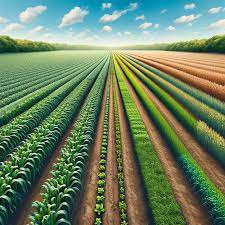No products in the cart.
Discover the Benefits of Strip Cultivation | Sustainable Farming
Cultivating the Future: Exploring the Benefits of Strip Cultivation
In recent years, sustainable farming practices have gained traction worldwide. Among these, strip cultivation stands out as a promising method for enhancing agricultural productivity while conserving natural resources. In this article, we’ll delve into the concept of strip cultivation, its benefits, and how it can revolutionize modern agriculture.

Table of Contents
| Sr# | Headings |
|---|---|
| 1 | What is Strip Cultivation? |
| 2 | How Does Strip Cultivation Work? |
| 3 | Advantages of Strip Cultivation |
| 4 | Environmental Impact |
| 5 | Economic Viability |
| 6 | Comparing Strip Cultivation to Other Methods |
| 7 | Implementing Strip Cultivation |
| 8 | Challenges to Consider |
| 9 | Future Prospects |
| 10 | Conclusion |
What is Strip Cultivation?
Strip cultivation is a method of farming where crops are cultivated in distinct strips or bands, rather than the traditional continuous rows. This technique allows for efficient use of land and resources, reducing soil erosion and enhancing overall crop yield.
How Does Strip Cultivation Work?
In strip cultivation, farmers divide their fields into narrower strips, often alternating between different crops or leaving some strips fallow. This practice helps to maintain soil fertility and structure over time. By rotating crops, the soil can naturally replenish nutrients while reducing the risk of pests and diseases.
Advantages of Strip Cultivation
Strip cultivation offers numerous benefits to both farmers and the environment. One of the key advantages is its ability to:
- Preserve Soil Quality: By minimizing soil erosion and maintaining nutrient levels, strip cultivation helps to preserve the long-term health of agricultural land.
- Increase Biodiversity: Alternating crop types and leaving strips fallow can foster biodiversity, supporting beneficial insects and wildlife.
- Enhance Water Management: The method improves water absorption and reduces runoff, helping to mitigate the impact of droughts and floods.
Environmental Impact
Strip cultivation significantly reduces the environmental footprint of agriculture. By promoting sustainable practices, it helps to:
- Minimize Chemical Runoff: Compared to conventional farming, strip cultivation requires fewer pesticides and fertilizers, reducing their impact on nearby ecosystems.
- Mitigate Climate Change: Enhanced soil health and reduced greenhouse gas emissions contribute to climate change mitigation efforts.
Economic Viability
From an economic perspective, strip cultivation can be more profitable than traditional methods due to:
- Lower Input Costs: Reduced need for fertilizers and pesticides lowers production costs.
- Increased Yield Stability: Diversifying crops within strips can stabilize yields against weather fluctuations.
Comparing Strip Cultivation to Other Methods
Strip cultivation contrasts with other farming methods such as monoculture and contour farming. It offers distinct advantages in terms of:
- Sustainability: Monoculture depletes soil nutrients faster, while contour farming may not be as effective in water management as strip cultivation.
Implementing Strip Cultivation
To adopt strip cultivation successfully, farmers should:
- Plan Ahead: Design field layouts that optimize water use and crop rotation.
- Invest in Education: Training and resources can help farmers transition successfully to new methods.
Challenges to Consider
Despite its benefits, strip cultivation poses challenges such as:
- Initial Investment: Transitioning to strip cultivation may require upfront investments in equipment and training.
- Adaptation Period: Farmers may need time to adjust to new practices and overcome initial yield variations.
Future Prospects
The future of strip cultivation looks promising, with ongoing research focusing on:
- Optimizing Techniques: Fine-tuning strip width and crop rotation to maximize yield and sustainability.
- Scaling Up: Increasing adoption rates among farmers globally to reap the full benefits.
Conclusion
In conclusion, strip cultivation represents a sustainable approach to modern agriculture that benefits both farmers and the environment. By preserving soil quality, enhancing biodiversity, and improving water management, this method offers a path towards a more resilient and productive farming future.
Frequently Asked Questions (FAQs)
What crops are suitable for strip cultivation?
Strip cultivation is suitable for a wide range of crops, including grains, vegetables, and legumes. The key is to select crops that complement each other in terms of nutrient requirements and growth cycles.
How does strip cultivation compare to traditional farming methods?
Unlike traditional farming methods, strip cultivation involves planting crops in narrow, alternating strips. This helps to reduce soil erosion, improve water management, and increase biodiversity compared to conventional continuous row planting.
Does strip cultivation require special equipment?
While strip cultivation does not necessarily require special equipment, some adjustments may be needed, such as modifying planting equipment to accommodate narrower rows or adjusting irrigation systems.
Can strip cultivation be used in organic farming?
Yes, strip cultivation is compatible with organic farming principles. By reducing the need for synthetic fertilizers and pesticides, it supports organic farming practices and enhances soil health naturally.
What are the environmental benefits of strip cultivation?
Strip cultivation offers several environmental benefits, including reduced soil erosion, improved water management, and increased biodiversity. These factors contribute to more sustainable agricultural practices.
Go and turn on towards organic farming to save future and thire save childs:
Elevate Plant Growth with Premium Bone Powder – Buy Now!
Organic Cow Dung Compost: Transform Your Garden Naturally
Premium Humic Acid for Healthy Plants | Enhance Soil & Boost Growth
Boost Plant Growth Naturally with Mustard Cake | Organic Fertilizer
Transform Your Garden with NPK Fertilizer | Boost Growth by 30%
Premium Perlite for Enhanced Gardening | Buy Now
Live Earthworms with Enhance Your Garden (soil health)
1 Neem Khali: Unveiling the Wonders of Nature
1Transform your garden with vermiwash-buy now
1 Premium quality Vermicompost [ केचुआ खाद ]
Follow us:
Tagged Instrip cultivation



